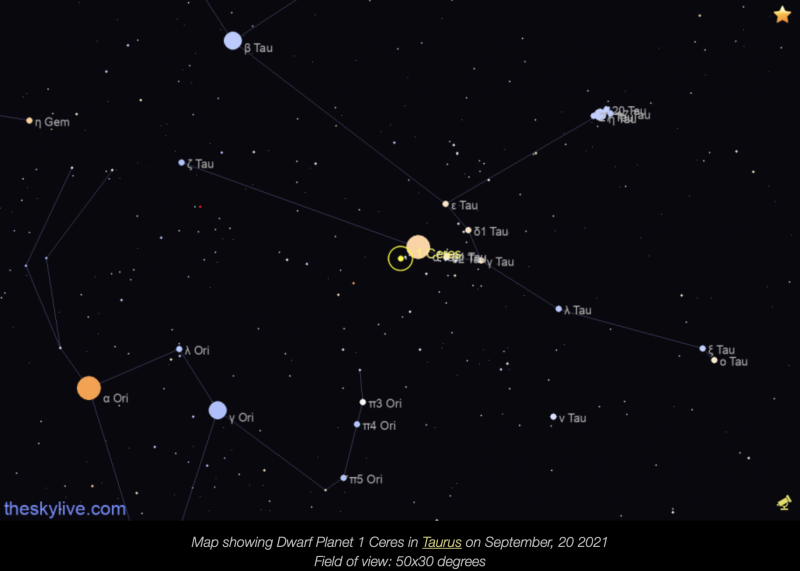Ceres at opposition in November (earthsky.org)
Posted by Kelly Kizer Whitt
November 3, 2021
Ceres was the first asteroid discovered, in 1801. The International Astronomical Union reclassified it and Pluto as dwarf planets in 2006. Ceres is the largest object in the asteroid belt between Mars and Jupiter. It’s the only world in the asteroid belt with enough mass – and therefore enough self-gravity – to pull itself into the shape of a ball. So Ceres is the only dwarf planet in the asteroid belt, or even inside the orbit of Neptune, for that matter. In 2021, Ceres will be at opposition – opposite the sun in our sky – on November 27. At that time, it’ll rise at sunset and set at sunrise. Early November provides a unique opportunity to spot Ceres as it passes the bright star Aldebaran.
***
How to view Ceres at opposition
If you have a telescope or good binoculars, now is the time to start watching Ceres. Note that the name asteroid means starlike. From Earth, Ceres looks like a star. But because it’s so close to us, it can be seen to move in front of the stars from night to night.
Dust off your binoculars or telescope and head to a dark-sky site to see Ceres. The brightness of astronomical objects is measured in something called magnitude, with lower numbers indicating brighter objects. From a location free of light pollution, you can see objects down to about magnitude 6. In early November, the moon is near new phase, allowing for the darkest skies and better opportunities to pick out this dim world. Ceres is about magnitude 7.6 in early November, and will be at its brightest (magnitude 7) in late November. So you can see you’ll need optical aid to bag this unique object.
Ceres will move in front of the constellation Taurus the Bull all through November. Specifically, you’ll want to look for it within the V-shape Hyades star cluster in Taurus. Look now to find it near the bright reddish-orange star Aldebaran, the brightest star in Taurus.
Ceres near Aldebaran
The easiest time to find Ceres in 2021 might be the first few days of November. Ceres will pass less than a moon’s width from Aldebaran in Taurus around these evenings. If you focus binoculars or a telescope on Aldebaran, the point of light close to the star will be Ceres. Sketch the field of view around Aldebaran, then come back on consecutive nights to see which “star” moved.
***

***
more: https://earthsky.org/astronomy-essentials/ceres-at-opposition/?utm_source=EarthSky+News
https://theskylive.com/ceres-info
There are multiple charts in the original. I chose the one which is visually clearest even for people w/out lots of stargazing experience -- the bright stars of Orion (lower left) and Taurus are some of the brightest and easiest to locate. The presence of two unmistakably red stars (Betelgeuse and Aldebaran) also helps a lot.
